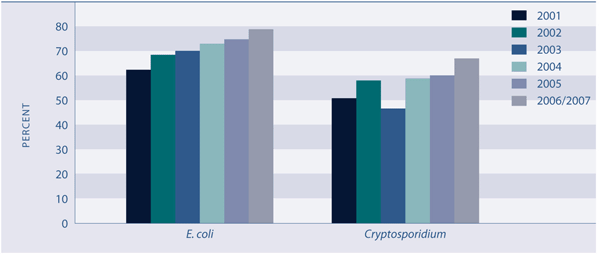Drinking water quality
Definition
The percentage of the estimated resident population who receive their water from community water supplies whose drinking water complies with either the 2000 or 2005 Drinking Water Standards of New Zealand relating to E. coli and Cryptosporidium.
Relevance
Good quality drinking water is critical for people’s health and their quality of life. The health risk to consumers from water-borne diseases in drinking water supplies comes from three main types of microorganisms: bacteria (such as Campylobacter and pathogenic E. coli), parasites (such as Giardia and Cryptosporidium) and viruses such as Norovirus. Improvements in this indicator suggest less of the population is at risk of water-borne diseases and other microbiological contaminants.
Current level and trends
Most New Zealanders are supplied with drinking water that complies with the microbiological standards. However, many smaller communities are supplied with microbiologically non-compliant drinking water. In 2006/2007, the proportion of the total population whose drinking water, measured at the tap, complied with the Drinking Water Standards for E. coli was 79 percent. This was an increase from 75 percent in 2005 and a considerable improvement from 62 percent in 2001. Most water supplies serving large population areas are fully compliant with the Drinking Water Standards. A significant reason for non-compliance is inadequate monitoring rather than proven contamination of drinking water.
Compliance with the Drinking Water Standards for Cryptosporidium is assessed at the water treatment plant rather than at the tap. In 2006/2007, the Cryptosporidium compliance rate was 67 percent. This was an improvement on the 2005 rate of 60 percent, and on the 2001 rate of 51 percent. Compliance rates for Cryptosporidium dropped in 2003 to 47 percent, but recovered to 59 percent in 2004. The drop in the compliance rate in 2003 was largely due to non-compliance at the Waitakere plant, which has since been resolved.
Figure EN2.1 Proportion of the population served with water that meets the relevant Drinking Water Standards, 2001–2006/2007

Source: ESR (Environmental Science and Research), customised data
Notes: (1) The measurement of compliance has moved from a calendar year to the fiscal year (2) These compliance rates may differ when compared to Ministry of Health publications due to methodological differences explained in Appendix 2
Regional differences
The current transition between the 2000 and 2005 Drinking Water Standards is scheduled to take several years to complete, with drinking water suppliers choosing which of these standards to operate under in the meantime. Therefore, some regions will have moved to the 2005 standards while others will still be using the 2000 standards.
There is considerable regional variation in the population served with drinking water that is fully compliant with the 2000 or 2005 Drinking Water Standards for E. coli and Cryptosporidium. Between 2002 and 2005, less than 5 percent of the population in the Marlborough region was served with drinking water that fully complied with the Drinking Water Standards for E. coli. In 2006/2007 this significantly increased to 75 percent. The West Coast region had low compliance rates with E. coli standards in 2004 (34 percent) and 2005 (33 percent), and did not improve in 2006/2007 (35 percent). Compliance was highest in the Nelson (93 percent), and Auckland and Canterbury (both 91 percent) regions.
In 2006/2007, none of the population in the Marlborough and Gisborne regions was supplied with drinking water that fully complied with the Drinking Water Standards for Cryptosporidium. None of the population in Marlborough has had drinking water that complied with the standards for Cryptosporidium since 2001. In 2006/2007, less than 1 percent of the population in the West Coast region and less than 5 percent of the population in the Tasman region were supplied with fully-compliant drinking water. Compliance with Cryptosporidium standards was highest in the Nelson (97 percent), Auckland (88 percent) and Wellington (84 percent) regions.
International comparison
Overall, the quality of New Zealand’s drinking water is comparable with other developed countries. New Zealand’s water supplies are free of many of the pathogens that result in sickness and death in some parts of the world. However, the incidence of Giardia infection in New Zealand is 85 per 100,000 people, which is considered high compared to the reported rates for other western countries.92 The contribution of contaminated drinking water to the incidence of giardiasis is not known. |

